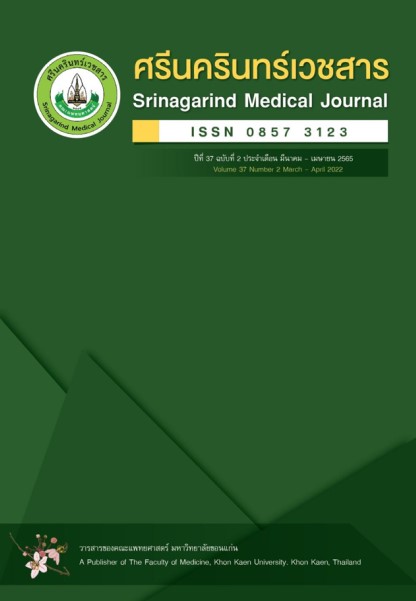Antibacterial Activity of Ethanolic Extract of Sida acuta Burm. F. Leaves Against Bacteria Isolated from Stone Matrices
Antibacterial activity of ethanolic extract of Sida acuta Burm. F. leaves
Keywords:
antibacteria, flavonoid, Sida acuta Burm. F., bacteria, kidney stoneAbstract
Background and Objective: The incidence of multidrug-resistant bacteria isolated from stone matrices of kidney stone patients has increased dramatically. Many plant extracts have been studied for antibacterial activity. Therefore, this study aimed to evaluate the antibacterial activity of the ethanolic extract of Sida acuta Burm. F. leaves (EESA) against bacteria isolated from kidney stone matrices.
Methods: The antibacterial activity of EESA was evaluated against two groups of bacteria, reference strains and clinical strains isolated from stone matrices by using the broth microdilution method. Each group of bacteria included three Gram-positive and three Gram-negative bacteria. Total flavonoid content of EESA was also determined.
Results: The minimum inhibitory concentrations of EESA against both reference and clinical strains for Gram-positive bacteria were in the range of 1-8 mg/mL whereas those of both groups for Gram-negative bacteria were in the range of 16-32 mg/mL. The best inhibitory activity of the EESA was observed against Staphylococcus saprophyticus. The EESA revealed the presence of flavonoids.
Conclusion: The EESA had antibacterial activity and flavonoids. The EESA may be developed as an alternative drug for the prevention and treatment of kidney stone disease with urinary tract infection especially S. saprophyticus.
References
Kasew D, Eshetie S, Diress A, Tegegne Z and Moges F. Multiple drug resistance bacterial isolates and associated factors among urinary stone patients at the University of Gondar Comprehensive Specialized Hospital, Northwest Ethiopia. BMC Urol 2021; 21: 27.
Miano R, Germani S, Vespasiani G. Stones and urinary tract infections. Urol Int 2007; 79: 32-6.
Tavichakorntrakool R, Prasongwattana V, Sungkeeree S, Saisud P, Sribenjalux P, Pimratana C, et al. Extensive characterizations of bacteria isolated from catheterized urine and stone matrices in patients with nephrolithiasis. Nephrol Dial Transplant 2012;27:4125-30.
Abat JK, Kumar S, Mohanty A. Ethnomedicinal, phytochemical and ethnopharmacological aspects of four medicinal plants of Malvaceae used in Indian traditional medicines: A review. Medicines 2017; 4: 75.
Ekpo MA, Etim PC. Antimicrobial activity of ethanolic and aqueous extracts of Sida acuta on microorganisms from skin infections. J Med Plants Res 2009;3:621-4.
Mohideen S, Sasikala E, Gopal V. Pharmacognostic studies on Sida acuta Burm. F. Anc Sci Life 2002;22:57-66.
Chumpol W, Tavichakorntrakool R, Lulitanond A, Daduang J, Saisud P, Sribenjalux P, et al. The antibacterial activity of the aqueous extract of Sida acuta Burm. F. Southeast Asian J Trop Med Public Health 2018;49:285-91.
CLSI. Performance standards for antimicrobial susceptibility testing. CLSI supplement M100. 30th ed. Wayne: Clinical and Laboratory Standards Institute; 2020.
Smanthong N, Tavichakorntrakool R, Tippayawat P, Lulitanond A, Pinlaor P, Daduang J, et al. Anti-Proteus activity, anti-struvite crystal, and phytochemical analysis of Sida acuta Burm. F. ethanolic leaf extract. Molecules 2022;27:1092.
Promraksa B, Daduang J, Chaiyarit P, Tavichakorntrakool R, Khampitak T, Rattanata N, et al. Cytotoxicity of Cratoxylum formosum subsp. pruniflorum gogel extracts in oral cancer cell lines. Asian Pac J Cancer Prev 2015;16:7155-9.
Adamczak A, Ozarowski M, Karpinski TM. Antibacterial activity of some flavonoids and organic acids widely distributed in plants. J Clin Med 2019;9:109.
Xie Y, Yang W, Tang F, Chen X, Ren L. Antibacterial activities of flavonoids: structure-activity relationship and mechanism. Curr Med Chem 2015;22:132-49.
Akinnibosun FI, Pela B. Evaluation of the phytochemicals and the antibacterial properties of Sida acuta leaf extract and their effects on wound bacterial isolates. ChemSearch J 2015;6:70-6.
Osonga FJ, Akgul A, Miller RM, Eshun GB, Yazgan I, Akgul A, Sadik OA. Antimicrobial activity of a new class of phosphorylated and modified flavonoids. ACS Omega 2019;4:12865-71.
Yuan G, Guan Y, Yi H, Lai S, Sun Y, Cao S. Antibacterial activity and mechanism of plant flavonoids to Gram-positive bacteria predicted from their lipophilicities. Sci Rep 2021;11:10471
Downloads
Published
How to Cite
Issue
Section
License
Copyright (c) 2022 Srinagarind Medical Journal

This work is licensed under a Creative Commons Attribution-NonCommercial-NoDerivatives 4.0 International License.




